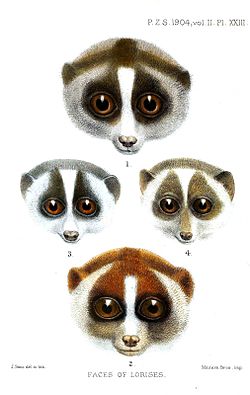| Lorises Temporal range: Miocene to present | |
|---|---|
 | |
| Joseph Smit's Faces of Lorises (1904) | |
| Scientific classification | |
| Kingdom: | Animalia |
| Phylum: | Chordata |
| Class: | Mammalia |
| Order: | Primates |
| Suborder: | Strepsirrhini |
| Family: | Lorisidae |
| Subfamily: | Lorinae Gray, 1821 [1] |
| Genera | |
| Synonyms | |
| |
Loris is the common name for the wet-nosed primates of the subfamily Lorinae [1] (sometimes spelled Lorisinae [2] ) in the family Lorisidae. Loris is one genus in this subfamily and includes the slender lorises, Nycticebus is the genus containing the slow lorises, and Xanthonycticebus is the genus name of the pygmy slow loris.